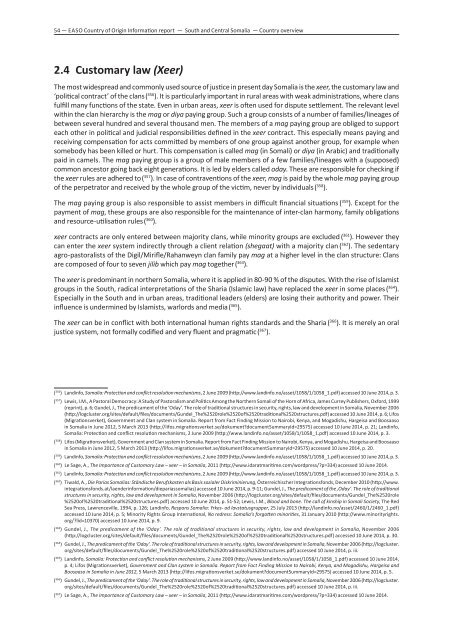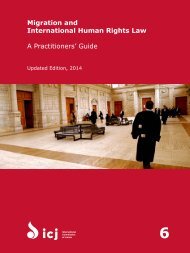Create successful ePaper yourself
Turn your PDF publications into a flip-book with our unique Google optimized e-Paper software.
54 — EASO Country of Origin Information report — South and Central <strong>Somalia</strong> — Country overview<br />
2.4 Customary law (Xeer)<br />
The most widespread and commonly used source of justice in present day <strong>Somalia</strong> is the xeer, the customary law and<br />
‘political contract’ of the clans ( 356 ). It is particularly important in rural areas with weak administrations, where clans<br />
fulfill many functions of the state. Even in urban areas, xeer is often used for dispute settlement. The relevant level<br />
within the clan hierarchy is the mag or diya paying group. Such a group consists of a number of families/lineages of<br />
between several hundred and several thousand men. The members of a mag paying group are obliged to support<br />
each other in political and judicial responsibilities defined in the xeer contract. This especially means paying and<br />
receiving compensation for acts committed by members of one group against another group, for example when<br />
somebody has been killed or hurt. This compensation is called mag (in Somali) or diya (in Arabic) and traditionally<br />
paid in camels. The mag paying group is a group of male members of a few families/lineages with a (supposed)<br />
common ancestor going back eight generations. It is led by elders called oday. These are responsible for checking if<br />
the xeer rules are adhered to ( 357 ). In case of contraventions of the xeer, mag is paid by the whole mag paying group<br />
of the perpetrator and received by the whole group of the victim, never by individuals ( 358 ).<br />
The mag paying group is also responsible to assist members in difficult financial situations ( 359 ). Except for the<br />
payment of mag, these groups are also responsible for the maintenance of inter‐clan harmony, family obligations<br />
and resource‐utilisation rules ( 360 ).<br />
xeer contracts are only entered between majority clans, while minority groups are excluded ( 361 ). However they<br />
can enter the xeer system indirectly through a client relation (shegaat) with a majority clan ( 362 ). The sedentary<br />
agro‐pastoralists of the Digil/Mirifle/Rahanweyn clan family pay mag at a higher level in the clan structure: Clans<br />
are composed of four to seven jilib which pay mag together ( 363 ).<br />
The xeer is predominant in northern <strong>Somalia</strong>, where it is applied in 80-90 % of the disputes. With the rise of Islamist<br />
groups in the South, radical interpretations of the Sharia (Islamic law) have replaced the xeer in some places ( 364 ).<br />
Especially in the South and in urban areas, traditional leaders (elders) are losing their authority and power. Their<br />
influence is undermined by Islamists, warlords and media ( 365 ).<br />
The xeer can be in conflict with both international human rights standards and the Sharia ( 366 ). It is merely an oral<br />
justice system, not formally codified and very fluent and pragmatic ( 367 ).<br />
( 356 ) Landinfo, <strong>Somalia</strong>: Protection and conflict resolution mechanisms, 2 June 2009 (http://www.landinfo.no/asset/1058/1/1058_1.pdf) accessed 10 June 2014, p. 3.<br />
( 357 ) Lewis, I.M., A Pastoral Democracy: A Study of Pastoralism and Politics Among the Northern Somali of the Horn of Africa, James Currey Publishers, Oxford, 1999<br />
(reprint), p. 6; Gundel, J., The predicament of the ‘Oday’. The role of traditional structures in security, rights, law and development in <strong>Somalia</strong>, November 2006<br />
(http://logcluster.org/sites/default/files/documents/Gundel_The%2520role%2520of%2520traditional%2520structures.pdf) accessed 10 June 2014, p. 6; Lifos<br />
(Migrationsverket), Government and Clan system in <strong>Somalia</strong>. <strong>Report</strong> from Fact Finding Mission to Nairobi, Kenya, and Mogadishu, Hargeisa and Boosaaso<br />
in <strong>Somalia</strong> in June 2012, 5 March 2013 (http://lifos.migrationsverket.se/dokumentdocumentSummaryId=29575) accessed 10 June 2014, p. 21; Landinfo,<br />
<strong>Somalia</strong>: Protection and conflict resolution mechanisms, 2 June 2009 (http://www.landinfo.no/asset/1058/1/1058_1.pdf) accessed 10 June 2014, p. 3.<br />
( 358 ) Lifos (Migrationsverket), Government and Clan system in <strong>Somalia</strong>. <strong>Report</strong> from Fact Finding Mission to Nairobi, Kenya, and Mogadishu, Hargeisa and Boosaaso<br />
in <strong>Somalia</strong> in June 2012, 5 March 2013 (http://lifos.migrationsverket.se/dokumentdocumentSummaryId=29575) accessed 10 June 2014, p. 20.<br />
( 359 ) Landinfo, <strong>Somalia</strong>: Protection and conflict resolution mechanisms, 2 June 2009 (http://www.landinfo.no/asset/1058/1/1058_1.pdf) accessed 10 June 2014, p. 3.<br />
( 360 ) Le Sage, A., The Importance of Customary Law – xeer – in <strong>Somalia</strong>, 2011 (http://www.idaratmaritime.com/wordpress/p=334) accessed 10 June 2014.<br />
( 361 ) Landinfo, <strong>Somalia</strong>: Protection and conflict resolution mechanisms, 2 June 2009 (http://www.landinfo.no/asset/1058/1/1058_1.pdf) accessed 10 June 2014, p. 3.<br />
( 362 ) Tiwald, A., Die Parias <strong>Somalia</strong>s: Ständische Berufskasten als Basis sozialer Diskriminierung, Österreichischer Integrationsfonds, December 2010 (http://www.<br />
integrationsfonds.at/laenderinformation/diepariassomalias) accessed 10 June 2014, p. 9-11; Gundel, J., The predicament of the ‚Oday‘. The role of traditional<br />
structures in security, rights, law and development in <strong>Somalia</strong>, November 2006 (http://logcluster.org/sites/default/files/documents/Gundel_The%2520role<br />
%2520of%2520traditional%2520structures.pdf) accessed 10 June 2014, p. 51-52; Lewis, I.M., Blood and bone. The call of kinship in Somali Society, The Red<br />
Sea Press, Lawrenceville, 1994, p. 126; Landinfo, Respons <strong>Somalia</strong>: Yrkes- od lavstatusgrupper, 25 July 2013 (http://landinfo.no/asset/2460/1/2460_1.pdf)<br />
accessed 10 June 2014, p. 5; Minority Rights Group International, No redress: <strong>Somalia</strong>’s forgotten minorities, 31 January 2010 (http://www.minorityrights.<br />
org/lid=10370) accessed 10 June 2014, p. 9.<br />
( 363 ) Gundel, J., The predicament of the ‘Oday’. The role of traditional structures in security, rights, law and development in <strong>Somalia</strong>, November 2006<br />
(http://logcluster.org/sites/default/files/documents/Gundel_The%2520role%2520of%2520traditional%2520structures.pdf) accessed 10 June 2014, p. 30.<br />
( 364 ) Gundel, J., The predicament of the ‘Oday’. The role of traditional structures in security, rights, law and development in <strong>Somalia</strong>, November 2006 (http://logcluster.<br />
org/sites/default/files/documents/Gundel_The%2520role%2520of%2520traditional%2520structures.pdf) accessed 10 June 2014, p. iii.<br />
( 365 ) Landinfo, <strong>Somalia</strong>: Protection and conflict resolution mechanisms, 2 June 2009 (http://www.landinfo.no/asset/1058/1/1058_1.pdf) accessed 10 June 2014,<br />
p. 4; Lifos (Migrationsverket), Government and Clan system in <strong>Somalia</strong>. <strong>Report</strong> from Fact Finding Mission to Nairobi, Kenya, and Mogadishu, Hargeisa and<br />
Boosaaso in <strong>Somalia</strong> in June 2012, 5 March 2013 (http://lifos.migrationsverket.se/dokumentdocumentSummaryId=29575) accessed 10 June 2014, p. 5.<br />
( 366 ) Gundel, J., The predicament of the ‘Oday’. The role of traditional structures in security, rights, law and development in <strong>Somalia</strong>, November 2006 (http://logcluster.<br />
org/sites/default/files/documents/Gundel_The%2520role%2520of%2520traditional%2520structures.pdf) accessed 10 June 2014, p. iii.<br />
( 367 ) Le Sage, A., The Importance of Customary Law – xeer – in <strong>Somalia</strong>, 2011 (http://www.idaratmaritime.com/wordpress/p=334) accessed 10 June 2014.



